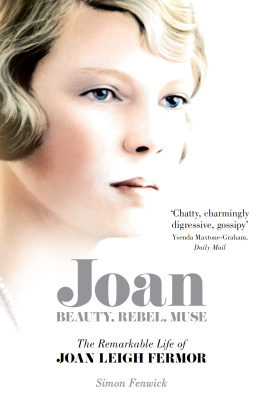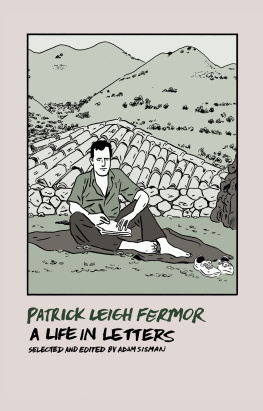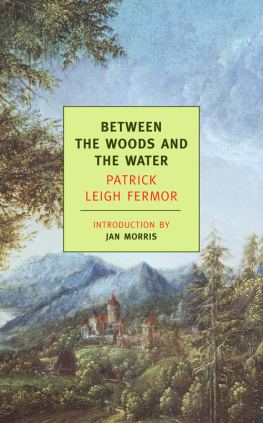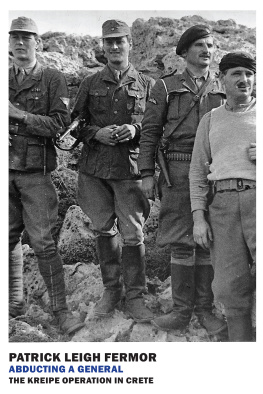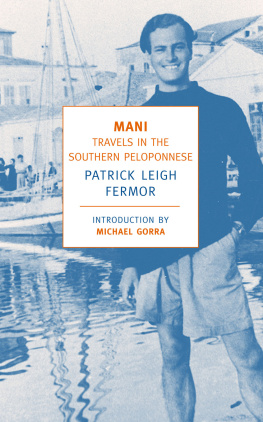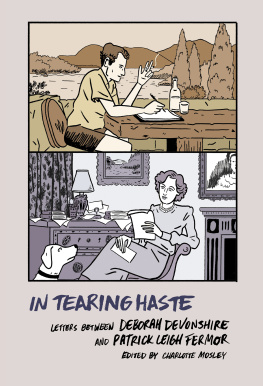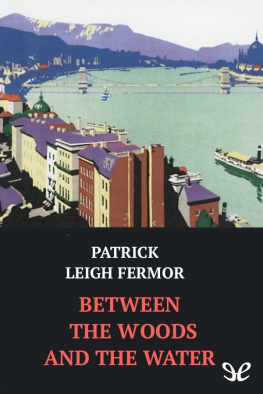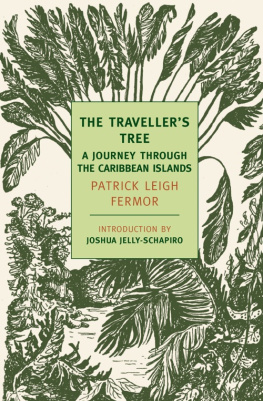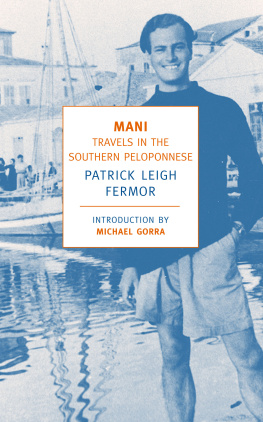JOAN
Beauty, Rebel, Muse:
The Remarkable Life of
Joan Leigh Fermor
SIMON FENWICK
PAN BOOKS
Contents
List of Illustrations

Introduction
J oan Leigh Fermors life encompassed much of the twentieth century and the very beginning of the twenty-first. Born Joan Eyres Monsell in London in 1912 she was brought up on her familys estate in Dumbleton in Gloucestershire. She died aged ninety-one in 2003 in a house which she and her husband Patrick Paddy Leigh Fermor built outside the village of Kardamyli in the southern Peloponnese. Joans mother was an heiress and her father, who was of Anglo-Irish descent, was a highly successful politician during the inter-war years. Whatever assumptions her parents had about the life their daughter might lead or thought she ought to lead Joans life turned out to be very different.
Joans formal education was slight: such matters were thought unimportant. All a girl of her class was obliged to do was find an eligible suitor. When Joans first lover, a young would-be writer called Alan Pryce-Jones, was found to have little money and doubtful prospects, he was soon sent packing. Pryce-Jones, though, was an incurably sociable young man and he moved in literary and bohemian circles; however brief their relationship, it changed her life. Through Alan, Joan met fashionable figures of the 1930s: the likes of John Betjeman, Cyril Connolly, Maurice Bowra, Brian Howard, Evelyn Waugh and Osbert Lancaster. They became her friends and Joan, who was beautiful, witty and fun, proved herself equal to their company. Throughout the 1930s Joan featured in the society pages of newspapers and magazines because of her clothes, because she went to the opera or the ballet or dined at the Ritz, or because she travelled to Russia with Robert Byron, or with Tom Driberg to New York.
In the 1930s Joan became interested in photography, which was a respectable means of earning a small income independent from her family allowance. She started to take pictures of her young intellectual friends. Betjeman was one, and it was he who suggested that she specialize in photographing architecture, an enthusiasm shared by them both. After the outbreak of World War II, she also took photographs of buildings destroyed by the bombing. In 1939 Joan married her first husband, John Rayner. Brought up in Dulwich, Rayner was a journalist. As features editor of the Daily Express and an influential figure in the world of newspapers, he had redesigned its layout when the Express was the biggest-selling newspaper in the country. However his marriage to Joan did not last: they had different ideas about the importance of marital fidelity.
In order to escape from the marriage Joan trained as a cryptographer and in 1942 she went to work abroad. In Cairo in late 1944 she met a young war hero called Paddy Leigh Fermor. They fell in love. Although Paddy and Joan were a couple for the rest of their lives they were frequently apart. Joan often stayed by herself in London or Gloucestershire and continued a highly sociable existence while Paddy went away to write usually abroad. They loved Greece and everything Greek. In the 1960s they were at last in a position to buy a plot of land in Greece and at Kardamyli they built a house on the very edge of the Mediterranean. Joan taught herself the language by reading Greek translations of Agatha Christie novels.
Joan made it possible for Paddy to write, the only thing he ever seriously wanted to do. Although Paddy became famous for his military adventures, these were, in a sense, achieved by accident: he was the right man in the right place at the right time. But as one of his close friends said of him, a man who was forever losing his mackintosh was not suited to be a regular soldier. Joan supported Paddy both emotionally and financially, enabling him to become one of the finest travel writers of the twentieth century. That said, Joan is scarcely mentioned in any of his books. In The Travellers Tree, Paddys first, he makes a few references, including a description of her taking three films of photographs in a cemetery on the island of Guadeloupe. Some of Joans pictures of monasteries in Anatolia are used to illustrate A Time to Keep Silence; and Mani (which is dedicated to Joan) and Roumeli, both of which are about Greece, include more of her work. The letters in Three Letters from the Andes were originally written to Joan. And this is all. Yet although diffident about her achievements, and deeply private, Joan was very far from being an anonymous figure.
In 1990 the academic and university administrator Noel Annan published a book called Our Age: Portrait of a Generation. Some four hundred and fifty pages long, Our Age is a tour de force, a sweeping history of British intellectual and political life during the course of the twentieth century. Annan begins by imagining who Maurice Bowra, the most famous Oxford don of the day, would claim to have made the times significant: to be a genuine member of Our Age it was not enough to be well-born, or well-known, or pleasure-loving. Nor was it enough to be a scholar. He liked people to be quick, intelligent and to delight in general ideas. Among them he would have included Joan: she was, Annan
This is a book about someone who enhanced many lives.
Paddy Leigh Fermor died in June 2011, eight years after Joan. I am an archivist, and was asked by the executors of the Leigh Fermor estate if I would go to Greece to sort out Paddys papers before they were returned to England. A month later, I flew out to Kardamyli. What I remember most vividly about my arrival at the house where Paddy and Joan had lived for forty years was the scent of the jasmine that grew within the interior courtyard. That first evening I went down to the beach below the house to take my first swim; the sea was warm I swam a lot that summer. Paddys archive was substantial and quite chaotic; I spent two months sorting, listing and packing the papers, and by the time I finished I had filled nineteen large cardboard cartons with Paddys records. I also filled nine black plastic sacks with rubbish broken pens, bits of cardboard, newspapers, half a pornographic novel without a cover (I never found the other half), and all manner of general detritus. Eventually, after I had left, the archives were shipped back to the UK. In 2012 the archive was purchased by the National Library of Scotland in Edinburgh with a grant from the John R. Murray Charitable Trust.
If Paddy was a hoarder, Joan was the very opposite. Although the Dumbleton estate records still exist (in Gloucestershire Records Office), there are few Eyres Monsell family papers among them. In 1959, during the sale of Dumbleton Hall, Joan wrote to Paddy about her mother who was getting desperately ill just in the middle of moving, refusing to give up, rushing up and downstairs sorting out some of Joans friends did keep her letters, and there are references to Joan in the biographies, autobiographies and published letters and diaries of her contemporaries, including those of John Betjeman, Maurice Bowra, Robert Byron, Cyril Connolly, James Lees-Milne, Nancy Mitford, Frances Partridge, Evelyn Waugh and, of course, Paddy. Also, importantly but untidily, there are about 3,000 photographs in Joans collection; these too are now in the National Library of Scotland.
Although so much has been written about Paddy Leigh Fermors life, no one had ever researched Joans own history and so little had been written about her long relationship with Paddy. And so it was suggested that Joan too might be a worthwhile subject for a book. In writing this book, I would like to thank Paddys god-daughter Olivia Stewart for her help at the start of the project, and the Paddy and Joan Leigh Fermor Arts Fund for making funds available for the original research.

